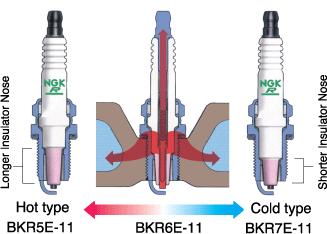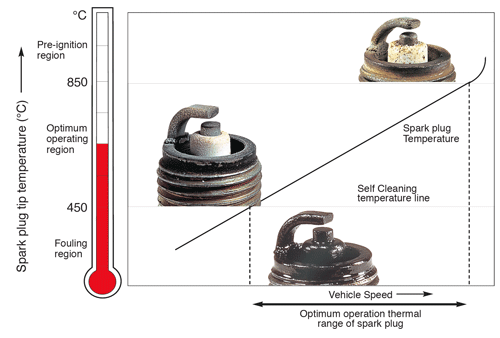Engine: Zenoah 260 Stock
Intake opens: 72° BTDC
closes: 72° ATDC
duration: 144°
Exhaust opens: 83,5°BBDC
closes: 83,5º ABDC
duration: 167°
Transfer opens: 62,5° BBDC
closes: 62,5° ABDC
duration: 125°
Squish band: 0,89 mm
Engine: Zenoah 260 Stock
Intake opens: 72° BTDC
closes: 72° ATDC
duration: 144°
Exhaust opens: 83,5°BBDC
closes: 83,5º ABDC
duration: 167°
Transfer opens: 62,5° BBDC
closes: 62,5° ABDC
duration: 125°
Squish band: 0,89 mm
Engine Terminology
Nicasil = Nikasil = NiCaSil = NiComm - A combination of nickel, silicon, and carbide are electro-plated to an aluminium cylinder and then diamond honed to a precise diameter. The advantage of this process is increased heat transfer and less weight compared to steel/cast sleeves.
Top Dead Center (TDC) - The top of the piston's stroke.Porting and Port Timing Terms
Spark plugs are one of the most misunderstood components of an engine. Numerous questions have surfaced over the years, leaving many people confused.
This guide is designed to assist the technician, hobbyist, or race mechanics in understanding, using, and troubleshooting spark plugs. The information contained in this guide applies to all types of internal combustion engines.
Spark plugs are the "window" into the engine , and can be used as a valuable diagnostic tool. Like a patient's thermometer, the spark plug displays symptoms and conditions of the engine. The experienced tuner can analyze these symptoms to track down the root cause of many problems, or determine air/fuel ratios.
SPARK PLUG BASICS:
The spark plug has two primary functions:
Spark plugs carry electrical energy and turn fuel into working energy. A sufficient amount of voltage must be supplied by the ignition system to spark across the spark plug's gap. This is called "Electrical Performance."
The temperature of the spark plug's firing end must be kept low enough to prevent pre-ignition, but high enough to prevent fouling. This is called "Thermal Performance", and is determined by the heat range selected.
It's important to remember spark plugs do not create heat, they only remove heat. The spark plug works as a heat exchanger
by pulling unwanted thermal energy away from the combustion chamber, and transferring the heat to the engine's cooling
system. The heat range is defined as a plug's ability to dissipate heat.
The rate of heat transfer is determined by:
A spark plug's heat range has no relationship to the actual voltage transferred through the spark plug. Rather, the heat range is a measure of the spark plug's ability to remove heat from the combustion chamber. The heat range measurement is determined by several factors; the length of the ceramic center insulator nose and its' ability to absorb and transfer combustion heat, the material composition of the insulator and center electrode material.
Heat rating and heat flow path of NGK Spark Plugs

The insulator nose length is the distance from the firing tip of the insulator to the point where insulator meets the metal shell. Since the insulator tip is the hottest part of the spark plug, the tip temperature is a primary factor in pre-ignition and fouling. Whether the spark plugs are fitted in a lawnmower, boat, or a race car, the spark plug tip temperature must remain between 500C-850°C. If the tip temperature is lower than 500°C, the insulator area surrounding the center electrode will not be hot enough to burn off carbon and combustion chamber deposits. These accumulated deposits can result in spark plug fouling leading to misfire. If the tip temperature is higher than 850°C the spark plug will overheat which may cause the ceramic around the center electrode to blister and the electrodes to melt. This may lead to pre-ignition/detonation and expensive engine damage. In identical spark plug types, the difference from one heat range to the next is the ability to remove approximately 70°C to 100°C from the combustion chamber. A projected style spark plug firing tip temperature is increased by 10°C to 20°C.
Tip Temperature and Firing End Appearance

The firing end appearance also depends on the spark plugs tip temperature. There are three basic diagnostic criteria for spark plugs: good, fouled and overheated. The borderline between the fouling and optimum operating regions (450° C ) is called the spark plug self-cleaning temperature. The temperature at this point is where the accumulated carbon and combustion deposits are burned off.
Keep in mind the insulator nose length is a determining factor in the heat range of a spark plug, the longer the insulator nose, the less heat is absorbed, and the further the heat must travel into the cylinder head water jackets. This means the plug has a higher internal temperature, and is said to be a hot plug. A hot spark plug maintains a higher internal operating temperature to burn off oil and carbon deposits, and has no relationship to spark quality or intensity.
Conversely, a cold spark plug has a shorter insulator nose and absorbs more combustion chamber heat. This heat travels a shorter distance, and allows the plug to operate at a lower internal temperature. A colder heat range is necessary when the engine is modified for performance, subjected to heavy loads, or is run at a high rpm for a significant period of time. Colder spark plugs remove heat quicker, reducing the chance of pre-ignition/detonation. Failure to use a cooler heat range in a modified application can lead to spark plug failure and severe engine damage.
Below is a list of external influences on a spark plug's operating temperature. The following symptoms or conditions may have an effect on the actual temperature of the spark plug. The spark plug cannot create these conditions, but it must be able to cope with the levels of heat...if not, the performance will suffer and engine damage can occur.
Air/Fuel Mixtures seriously affect engine performance and spark plug operating temperatures.
Higher Compression Ratios/Forced Induction will elevate spark plug tip and in-cylinder temperatures
Advancing Ignition Timing
Engine Speed and Load
Ambient Air Temperature
Humidity
Barometric Pressure/Altitude
Types of Abnormal Combustion
Pre-ignition
Detonation
Misfires
Fouling
You are not logged in.